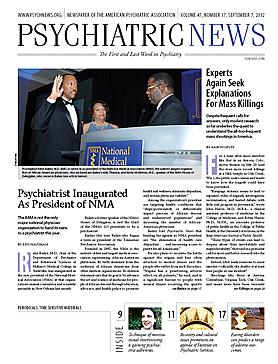You don’t have to be an “insider” to run for office in APA.
“I think a lot of people think there is something mysterious about being nominated for a position in APA and running for office,” said immediate past APA President John Oldham, M.D., chair of the APA Nominating Committee. “People may think it’s kind of an insider’s club, closed to members who haven’t been active in a highly visible way.”
Not so, he emphasized. Nominations are open to voting members in good standing, and the deadline for nominations for the 2013 election is October 1 (see Help Determine Tomorrow’s APA Leaders).
Oldham said many members may erroneously think they need to have previous Board or Assembly experience to be nominated for office. “We do want to see leadership experience, but administrative positions in academic departments, hospitals, or state and community agencies will easily translate,” he said.
So how does the nominating process work?
It starts with the appointment of members of the Nominating Committee. The president-elect appoints a chair, traditionally the immediate past president, and a member from each Area Council from a list of three names submitted from each Area Council and the Nominating Committee.
In addition, a new Board position representing minority and underrepresented groups has been created; the Assembly Committee of Minority/Underrepresented (M/UR) Groups will likewise submit a list of three candidates when that position is up for election.
The Nominating Committee selects at least two candidates for each office up for election in a given year—not all positions are up for election each year, since the length of the terms varies by position. Offices include president-elect, secretary, treasurer, early career psychiatrist trustee-at-large, trustee-at-large, member-in-training trustee-elect, and M/UR trustee.
The seven Area trustees are elected on a rotating basis for three-year terms.
Recommendations for nominations are solicited through standard announcements in Psychiatric News, the Daily Bulletin at APA’s annual meeting, a link on the APA Web site, and letters to district branches, Area councils, and residency programs.
A form is sent to every eligible member who is recommended for nomination to ascertain whether he or she wishes to be considered and, if so, which offices he or she is willing to accept. A potential nominee is asked to submit a brief statement of professional activities and to complete a standard disclosure of interests and affiliations and a statement that there are no charges of unethical behavior pending at the district-branch or state-association level.
The committee holds conference calls during the summer to discuss operating procedures and to make preliminary selections after reviewing the potential nominees’ forms and other materials. The committee then meets to make its final selections and secure acceptances by the nominees.
The process for selecting nominees for the member-in-training trustee-elect (MITTE) is more complex. To be eligible for consideration, residents must be APA members-in-training and in their PGY-2 or PGY-3 year the summer prior to the election, and they must have the training director or department chair sign a statement indicating that if the resident is elected, the training director agrees to allow him or her to honor the two-year commitment as MITTE and member-in-training trustee (MITT) as part of training. PGY-3 residents must plan to be in training through PGY-5 so as to be in training through the term as MITT and must submit a signed statement of intent to do so. Residents seeking nomination submit contact and demographic information, a curriculum vitae, and a one-page personal statement.
The residents’ materials are reviewed by the MITTE Nominating Subcommittee, chaired by the immediate past MITT and composed of the current MITT, the Assembly Committee of Area MIT Representatives, and a representative of the fellowship groups chosen on a rotating basis. This subcommittee reviews the submissions and recommends its top five choices to the Nominating Committee, which selects the final nominees.
A new position has been added to the Board effective with the 2013 election—the M/UR trustee. Candidates for the position must belong to their respective M/UR caucus by June 15 and be nominated by caucus vetting panels. Each vetting panel submits no more than one candidate to the Assembly Committee of Representatives of M/UR Groups. That committee submits two candidates and one alternate to the Nominating Committee; the M/UR trustee is eligible to serve two two-year terms.
APA members may also be nominated by a petition signed by 400 eligible voting members (100 for Area trustee and for MITTE). The petition must be submitted by November 15 of the year prior to the election.
Oldham emphasized that the most important qualification is not the length of one’s resume, but the strength of commitment to APA’s vision.
“We’d like to see people who are bridge builders,” Oldham said. “We want strong leaders who support what we are trying to do on the Board, which is to develop a collaborative team with a common agenda of improving care for our patients.”
Offices up for election in 2013 (the next election cycle) are president-elect, secretary, M/UR trustee, member-in-training trustee-elect, Area 3 trustee, and Area 6 trustee.

